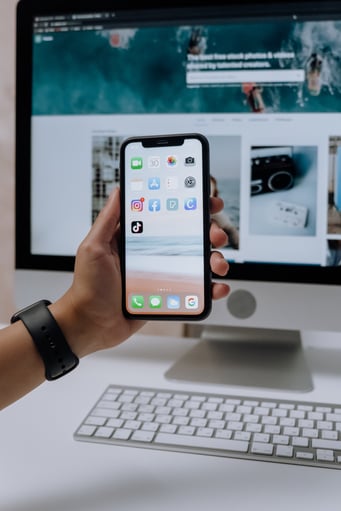Developing a mobile app does not immediately mean financial success. To generate revenue, you need the right strategy and a well-thought-out business model. An idea itself is not enough to monetize an app. It is equally important to take consistent actions that will encourage app users to spend. Who wouldn't want to effectively reach the audience and earn at the same time. In this article, we will take a look at the known ways of monetizing mobile apps and discuss their impact on financial revenue.
Table of Contents:
1. How to start mobile app monetization?
1.1. What is the most important in app monetization models?
1.2. How to make your app monetization method profitable?
2. Examples of app monetization models (Best app monetization strategies).
2.7. Sponsors and Partnerships.
How to start mobile app monetization?
Before you start conquering the world with your solution, it is worthwhile for you to know the market realities. And these seemingly do not look optimistic. Most users prefer free apps on their devices then paid apps. In the case of devices with iOS operating system it is as much as 90%, while among the Android system owners this result is as high as 95%. The user should have a well illustrated benefit of the expense or app subscription model. Lack of proper communication with the consumer or poor choice of financing method can have a negative impact on the interest in premium version of the product.
Monetize mobile apps on the surface seems like a complicated process. After all, the choice of app monetization strategy often determines the further results of the project. Nevertheless, good management combined with satisfying user expectations can bring a company closer to success.

What is the most important in app monetization models?
Before we look at the different ways of monetizing a mobile app, it is useful to know what is most important in the whole process. The key is to arouse the user's need to fund the product in exchange for satisfying their needs. Therefore, it is important to observe the user experience, which provides the necessary information about the user's level of satisfaction. A dissatisfied target audience will certainly not decide to incur additional costs for app subscriptions, just as a poorly executed funding strategy can take a toll on customer morale. Decrease in satisfaction can reflect not only on the financial aspect, but also on the overall interest in the application by new users.
How to make your app monetization method profitable?
The mobile app monetization strategy is to generate revenue from the application you own. There are many approaches as to which one is most effective. Like the discussions related to whether to focus on one app monetization strategy or perhaps choose a hybrid approach. That is why the final decision should be fully considered and informed. Besides, the number of mobile apps in stores dedicated to the most popular platforms exceeds several million. Due to such a big competition and the possibility of choice, the mobile apps should be refined and encouraging to use. The next step is the decision influencing the conversion of users.
Examples of app monetization models (Best app monetization strategies)
In-app purchases
As you already know, there are free and paid apps. In general, more belong to the freemium app monetization model. This means that you can access it without any additional costs. Just because users have the opportunity to download an free app or free game doesn't mean that opportunities to spend money don't arise. In-app purchases or so-called micropayments are examples of funding offered in exchange for additional facilities. Most often found in mobile games. Thanks to financial support, the user can exceed the imposed limits in free versions. When deciding to include mobile app revenue model, it is also important to maintain an appropriate balance between functionalities offered in free and paid versions.

Subscription apps
In the subscription model, the developer offers its users a different experience than the free app model. This could be the elimination of ads within the app, as in the case of streaming services such as Spotify. Another example is extending services with additional content not available to users of the free version of the mobile app. These include press applications that require funding in exchange for particular publications. This kind of practice is used, among others, by The New York Times.
Freemium
Freemium is popular app monetization strategy that is based on encouraging users to explore the free version of the application and then download the extended paid version. The benefit of this model is that users get to experience the functionality of the product and then decide to upgrade. Freemium apps increase the trust of the audience without the need to engage them more. One app attributed to the traditional freemium strategy is Dropbox.
Pay-Per-Download
This is probably the simplest solution found in this list. The mobile app, like every product in the app stores, has its value. To learn about its capabilities and use the functionality, the user must spend a certain amount of money before app downloads. However, this monetization method has many limitations. Deciding on this method, you should not expect success similar to the free app. This is due to, among other things, the habits of a modern user. Access to a wide base of free apps and uncertainty about the real need to buy make the application in this model must attract attention and encourage quality.
In-app advertising
When deciding to develop in app advertising, you should be extremely careful. App users do not like screen ads that are not tailored to their needs. The user experience is also negatively affected by advertising content presented in a pushy manner. Lack of personalization or pop-up banner ads from every corner of the app make it difficult to retain the user. It is worth taking care of the golden mean that will make sponsored content still visible, but will not affect the user experience of the mobile app.
Mailing list
Competition for users continues in every corner of the internet. And while it might seem that social media is the perfect form of self-promotion, in some ways a mailing list is just as effective. The life cycle of a post on any social media platform is relatively short. In the case of an email, you get a notification of the message in your inbox, and it further increases awareness of your brand's existence. Email itself is not everything. It usually includes a form that encourages you to take up a subscription. The vision of greater benefits resulting from additional fees is often convincing. However, too frequent mailing in connection with not very valuable content can be considered as spam, which can translate into decreasing interest in the product.

Sponsors and Partnerships
The collaboration between the two entities can also apply to mobile apps. Particularly when these are companies reaching a similar audience and not competing with each other. In such a situation, profits are generated on the basis of mutual recommendations, which may convince users to familiarize themselves with the application. Especially if it is recommended by a source they know. One of the app monetization methods in this case is providing advertising space so that interest in the product comes from an external source.
Summary
It is difficult to point out clearly the solution that will make your app start generating big profits. For this reason, you should do proper research beforehand. In order to generate as much revenue as possible, it is worth considering several app monetization methods implemented at the same time. Looking at your competitors and their practices can be useful. Providing a better user experience can help migrate between mobile apps in your favor. Don't treat app monetization strategy as a side issue. It is a very important aspect that not only affects the finances of the business, but also its growth.


%20(1).jpg)



